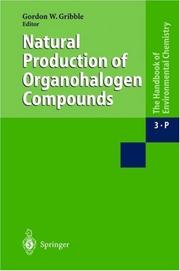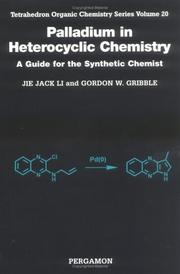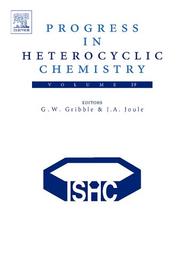| Listing 1 - 10 of 55 | << page >> |
Sort by
|
Book
ISBN: 321199324X 3211993223 1282509330 9786612509339 3211993231 Year: 2010 Publisher: Wien ; New York : Springer,
Abstract | Keywords | Export | Availability | Bookmark
 Loading...
Loading...Choose an application
- Reference Manager
- EndNote
- RefWorks (Direct export to RefWorks)
Despite the long association of organohalogen compounds with human activities, nature is the producer of nearly 5,000 halogen-containing chemicals. Once dismissed as accidents of nature or isolation artifacts, organohalogen compounds represent an important and ever growing class of natural products, in many cases exhibiting exceptional biological activity. Since the last comprehensive review in 1996 (Vol. 68, this series), there have been discovered an additional 2,500 organochlorine, organobromine, and other organohalogen compounds. These natural organohalogens are biosynthesized by bacteria, fungi, lichen, plants, marine organisms of all types, insects, and higher animals including humans. These compounds are also formed abiogenically, as in volcanoes, forest fires, and other geothermal events.In some instances, natural organohalogens are precisely the same chemicals that man synthesizes for industrial use, and some of the quantities of these natural chemicals far exceed the quantities emitted by man.
Environmental toxicology. --- Halogen compounds. --- Organohalogen compounds. --- Persistent pollutants. --- Organohalogen compounds --- Heterocyclic Compounds, 1-Ring --- Dioxins --- Heterocyclic Compounds --- Chemicals and Drugs --- Civil & Environmental Engineering --- Chemistry --- Environmental Engineering --- Biochemistry --- Physical Sciences & Mathematics --- Engineering & Applied Sciences --- Biodegradation. --- Biocorrosion --- Biodecay --- Biodecomposition --- Biodeterioration --- Biological corrosion --- Biological decay --- Biological decomposition --- Biological degradation --- Decay, Biological --- Decomposition (Biology) --- Degradation, Biological --- Halogen organic compounds --- Halogenated organic compounds --- Chemistry. --- Pharmacy. --- Organic chemistry. --- Organic Chemistry. --- Decomposition (Chemistry) --- Microbiology --- Halogen compounds --- Organic compounds --- Chemistry, Organic. --- Medicine --- Drugs --- Materia medica --- Pharmacology --- Organic chemistry

ISBN: 3540418423 Year: 2003 Publisher: Berlin : Springer,
Abstract | Keywords | Export | Availability | Bookmark
 Loading...
Loading...Choose an application
- Reference Manager
- EndNote
- RefWorks (Direct export to RefWorks)
Samenvatting:This book summarizes the state-of-the-art knowledge on naturallyoccurring organohalogens, of which more than 3700 are documented. Thechapters cover all aspects of this field, including the structuraldiversity and sources of organohalogens, the mechanisms for theirformation and biodegradation, the clinical use of dichloroacetate, andthe synthesis of the powerful anticancer chlorine-containingcryptophycin. Both biogenic and abiogenic sources of organohalogens aretreated, the latter of which include volcanic emissions and abiogenicformation in soil. Halogenation in humans, fungi, and in the ocean arecovered in separate chapters. Sources and biosynthesis of the relativelyrare natural organofluorines are also discussed in this volume. By betterunderstanding of the role nature plays in the area of organohalogens, wecan more intelligently regulate the production, use, and disposal ofman-made organohalogen compounds.
Digital
ISBN: 9783642157332 9783642157325 9783642265440 9783642157349 Year: 2011 Publisher: Berlin, Heidelberg Springer Berlin Heidelberg
Abstract | Keywords | Export | Availability | Bookmark
 Loading...
Loading...Choose an application
- Reference Manager
- EndNote
- RefWorks (Direct export to RefWorks)
Yong-Jin Wu New Indole-Containing Medicinal Compounds Timothy C. Barden Indoles: Industrial, Agricultural and Over-the-Counter Uses Richard J. Sundberg Electrophilic Substitution Reactions of Indoles Tara L.S. Kishbaugh Reactions of Indole with Nucleophiles Erin Pelkey Metalation of Indole Jie Jack Li ∙ Gordon W. Gribble Metal-Catalyzed Cross-Coupling Reactions for Indoles Jeanese C. Badenock Radical Reactions of Indole Fariborz Firooznia ∙ Robert F. Kester ∙ Steven J. Berthel [2+2], [3+2] and [2+2+2] Cycloaddition Reactions of Indole Derivatives Steven J. Berthel ∙ Fariborz Firooznia ∙ Robert F. Kester [4+2] Cycloaddition Reactions of Indole Derivatives Jonathon S. Russel Oxindoles and Spirocyclic Variations: Strategies for C3 Functionalization Liangfeng Fu Advances in the Total Syntheses of Complex Indole Natural Products.
Digital
ISBN: 9783642317910 Year: 2012 Publisher: Berlin, Heidelberg Imprint: Springer
Abstract | Keywords | Export | Availability | Bookmark
 Loading...
Loading...Choose an application
- Reference Manager
- EndNote
- RefWorks (Direct export to RefWorks)
Descriptive organic chemistry --- Organic chemistry --- organometalische verbindingen --- organische chemie
Digital
ISBN: 9783211993231 9783211993248 9783709110997 9783211993224 Year: 2010 Publisher: Vienna Springer
Abstract | Keywords | Export | Availability | Bookmark
 Loading...
Loading...Choose an application
- Reference Manager
- EndNote
- RefWorks (Direct export to RefWorks)
Despite the long association of organohalogen compounds with human activities, nature is the producer of nearly 5,000 halogen-containing chemicals. Once dismissed as accidents of nature or isolation artifacts, organohalogen compounds represent an important and ever growing class of natural products, in many cases exhibiting exceptional biological activity. Since the last comprehensive review in 1996 (Vol. 68, this series), there have been discovered an additional 2,500 organochlorine, organobromine, and other organohalogen compounds. These natural organohalogens are biosynthesized by bacteria, fungi, lichen, plants, marine organisms of all types, insects, and higher animals including humans. These compounds are also formed abiogenically, as in volcanoes, forest fires, and other geothermal events.In some instances, natural organohalogens are precisely the same chemicals that man synthesizes for industrial use, and some of the quantities of these natural chemicals far exceed the quantities emitted by man.
Organic chemistry --- Pharmacology. Therapy --- organische chemie --- farmacologie --- insecten
Book
ISBN: 9783031266287 Year: 2023 Publisher: Cham Springer
Abstract | Keywords | Export | Availability | Bookmark
 Loading...
Loading...Choose an application
- Reference Manager
- EndNote
- RefWorks (Direct export to RefWorks)

ISBN: 0080437044 0080437052 9786612344985 1282344986 0080513484 9780080437057 9780080513485 9780080886749 0080886744 9780080437040 9781282344983 6612344989 Year: 2000 Publisher: Amsterdam, [Netherlands] : Pergamon,
Abstract | Keywords | Export | Availability | Bookmark
 Loading...
Loading...Choose an application
- Reference Manager
- EndNote
- RefWorks (Direct export to RefWorks)
Palladium in Heterocyclic Chemistry
Descriptive organic chemistry --- Heterocyclic Compounds. --- 661.898 --- 546.98 --- 547.057 --- Organopalladium compounds --- Palladium catalysts --- Heterocyclic compounds --- -#WSCH:LOSH --- Cycloids, Mixed (Chemistry) --- Heteroatomic compounds --- Heterocycles --- Mixed cycloids (Chemistry) --- Organic cyclic compounds --- Catalysts --- Palladium organic compounds --- Organotransition metal compounds --- Palladium compounds --- Compounds, Heterocyclic --- Palladium --- Organic chemistry--?.057 --- Synthesis --- Polycyclic Compounds --- 547.057 Organic chemistry--?.057 --- 546.98 Palladium --- 661.898 Palladium compounds --- Heterocyclic Compounds --- #WSCH:LOSH --- Organopalladium compounds. --- Palladium catalysts. --- Synthesis.

ISBN: 0080994091 0080994067 1299853358 9780080994093 9780080994062 0080454089 9780080454085 0080454070 9780080454078 Year: 2013 Publisher: Oxford : Elsevier,
Abstract | Keywords | Export | Availability | Bookmark
 Loading...
Loading...Choose an application
- Reference Manager
- EndNote
- RefWorks (Direct export to RefWorks)
Progress in Heterocyclic Chemistry is an annual review series commissioned by the International Society of Heterocyclic Chemistry (ISHC). Volumes in the series contain both highlights of the previous year's literature on heterocyclic chemistry and articles on new, developing topics of particular interest to heterocyclic chemists. The highlight chapters in Volume 25 are all written by leading researchers in their field, and these chapters constitute a systematic survey of the important original material reported in the literature of heterocyclic chemistry in 2012. As with previ
Chemistry --- Physical Sciences & Mathematics --- Organic Chemistry --- Heterocyclic chemistry. --- Heteroatomic chemistry --- Chemistry, Organic --- Heterocyclic chemistry
Book
ISBN: 1283621509 0080968082 9786613933959 0080968074 9780080968087 9780080968070 9780080968070 9781283621502 6613933953 Year: 2012 Publisher: Amsterdam : Elsevier,
Abstract | Keywords | Export | Availability | Bookmark
 Loading...
Loading...Choose an application
- Reference Manager
- EndNote
- RefWorks (Direct export to RefWorks)
""Progress in Heterocyclic Chemistry"" (PHC) an ongoing reference work on heterocyclic chemistry is published with the active involvement of The International Society of Heterocyclic Chemistry (ISHC) whose aim is to promote heterocyclic chemistry, in particular by serving as the primary sponsoring agency for the ISHC-Congress, a large biannual meeting attracting up to a thousand participants. Recognized as the premiere review of heterocyclic chemistryContributions from leading researchers in the fieldSystematic survey of the important 2011 heterocyclic
Heterocyclic chemistry -- Periodicals. --- Heterocyclic chemistry. --- Heterocyclic compounds -- Periodicals. --- Chemistry --- Physical Sciences & Mathematics --- Organic Chemistry --- Heterocyclic compounds. --- Cycloids, Mixed (Chemistry) --- Heteroatomic compounds --- Heterocycles --- Mixed cycloids (Chemistry) --- Organic cyclic compounds --- Heteroatomic chemistry --- Chemistry, Organic
Book
ISBN: 0081007558 0081007612 9780081007617 9780081007556 Year: 2016 Publisher: Amsterdam, Netherlands : Elsevier,
Abstract | Keywords | Export | Availability | Bookmark
 Loading...
Loading...Choose an application
- Reference Manager
- EndNote
- RefWorks (Direct export to RefWorks)
Heterocyclic chemistry. --- Heteroatomic chemistry --- Chemistry, Organic
| Listing 1 - 10 of 55 | << page >> |
Sort by
|

 Search
Search Feedback
Feedback About UniCat
About UniCat  Help
Help News
News